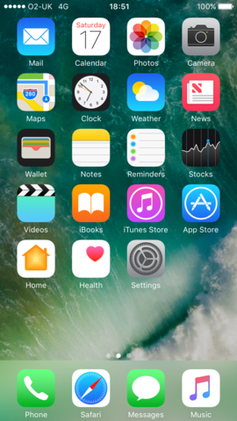 iOS (formerly iPhone OS) is a mobile operating system created and developed by Apple Inc. exclusively for its hardware. It is the operating system that presently powers many of the company's mobile devices, including the iPhone, iPad, and iPod Touch. It is the second most popular mobile operating system globally after Android. iPad tablets are also the second most popular, by sales, against Android since 2013.
iOS (formerly iPhone OS) is a mobile operating system created and developed by Apple Inc. exclusively for its hardware. It is the operating system that presently powers many of the company's mobile devices, including the iPhone, iPad, and iPod Touch. It is the second most popular mobile operating system globally after Android. iPad tablets are also the second most popular, by sales, against Android since 2013.
Originally unveiled in 2007 for the iPhone, iOS has been extended to support other Apple devices such as the iPod Touch (September 2007) and the iPad (January 2010). As of January 2017, Apple's App Store contains more than 2.2 million iOS applications,725,000 of which are native for iPads.These mobile apps have collectively been downloaded more than 130 billion times.
The iOS user interface is based upon direct manipulation, using multi-touch gestures. Interface control elements consist of sliders, switches, and buttons. Interaction with the OS includes gestures such as swipe, tap, pinch, and reverse pinch, all of which have specific definitions within the context of the iOS operating system and its multi-touch interface. Internal accelerometers are used by some applications to respond to shaking the device (one common result is the undo command) or rotating it in three dimensions (one common result is switching between portrait and landscape mode).
Major versions of iOS are released annually. The current version, iOS 10, was released on September 13, 2016.It runs on the iPhone 5 and later, iPad (4th generation) and later, iPad Pro, iPad Mini 2 and later, and the 6th-generation iPod Touch. In iOS, there are four abstraction layers: the Core OS, Core Services, Media, and Cocoa Touch layers.
History
In 2005, when Steve Jobs began planning the iPhone, he had a choice to either "shrink the Mac, which would be an epic feat of engineering, or enlarge the iPod". Jobs favored the former approach but pitted the Macintosh and iPod teams, led by Scott Forstall and Tony Fadell, respectively, against each other in an internal competition, with Forstall winning by creating the iPhone OS. The decision enabled the success of the iPhone as a platform for third-party developers: using a well-known desktop operating system as its basis allowed the many third-party Mac developers to write software for the iPhone with minimal retraining.Forstall also was responsible for creating a software developer's kit for programmers to build iPhone apps, as well as an App Store within iTunes.
The operating system was unveiled with the iPhone at the Macworld Conference & Expo, January 9, 2007, and released in June of that year.At first, Apple marketing literature did not specify a separate name for the operating system, stating simply what Steve Jobs claimed: "iPhone runs OS X" and runs "desktop applications"when in fact it runs a variant of [Mac] OS X, that doesn't run OS X software unless it has been ported to the incompatible operating system. Initially, third-party applications were not supported. Steve Jobs' reasoning was that developers could build web applications that "would behave like native apps on the iPhone".On October 17, 2007, Apple announced that a native Software Development Kit (SDK) was under development and that they planned to put it "in developers' hands in February".On March 6, 2008, Apple released the first beta, along with a new name for the operating system: "iPhone OS".
On September 5, 2007, Apple released the iPod Touch, which had most of the non-phone capabilities of the iPhone. Apple also sold more than one million iPhones during the 2007 holiday season.On January 27, 2010, Apple announced the iPad, featuring a larger screen than the iPhone and iPod Touch, and designed for web browsing, media consumption, and reading.
In June 2010, Apple rebranded iPhone OS as "iOS". The trademark "IOS" had been used by Cisco for over a decade for its operating system, IOS, used on its routers. To avoid any potential lawsuit, Apple licensed the "IOS" trademark from Cisco.
In October 2016, Apple opened its first iOS Developer Academy in Naples inside University of Naples Federico II's new campus.
No comments:
Post a Comment